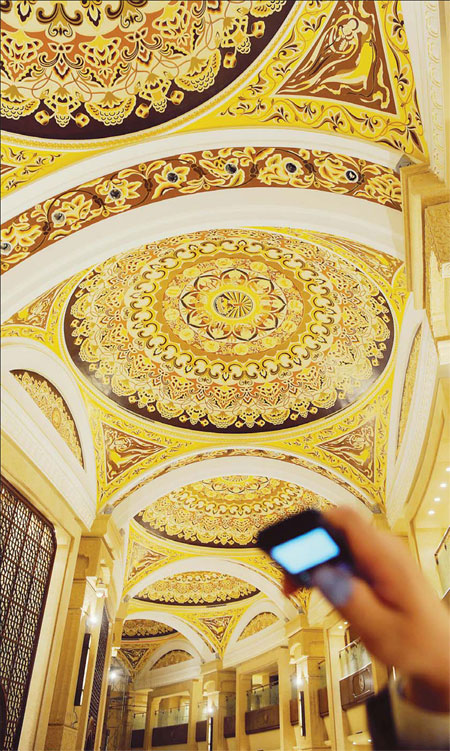
Reports put the cost of Fan Gong Palace at 1.6 billion yuan. Asianewsphoto
Wuxi's opulent Fan Gong Palace has to be seen to be believed, writes Yang Yijun.
Fan Gong Palace was purpose-built two years ago at the foot of Lingshan Mountain to host an international forum on Buddhism. It is made of gleaming white marble and features woodwork and other elements crafted by over 1,500 artisans from around the world.
The mountain in Wuxi, Jiangsu province, has long been known for its Buddhist heritage - particularly a bronze statue of Sakyamuni, the founder of Buddhism - but the palace adds an opulent new dimension. Its flawless design is breathtaking, while five gleaming towers hint at its luxurious interior.
Luxury and craftsmanship are really the quintessential elements of the palace, which the local government reportedly spent 1.6 billion yuan (US$240 million) in building.
Inside you immediately find yourself surrounded by woodcarvings, from the ornamental decorations that sit at the end of handrails to self-supporting four-meter-tall sculptures.
The tower hall in the center of the palace is so beautiful that words barely do it justice. Feitian, or sky gods, appear to soar along the rafters in the form of three-meter-tall sculptures.
The palace has 34 of these standing in various poses, such as poised on clouds or playing flutes. Three-dimensional frescoes add to the effect.
Walking through the hall, you can educate yourself about the origins and development of Buddhism by looking at the oil paintings on the walls.
At the end of the hall, a pure gold Buddha keeps watch. The shrine, called Lotus World, is decorated with tiny fragments of opal and jade, with 160 pieces of colored glaze lending it a picturesque background.
In Buddhist culture, the lotus flower is equated with virtue. The shrine pays homage to this by having 1,500 lights shaped in the form of lotus petals. These form an arc that reaches 30 meters at its apex. The lights appear like a celestial blanket as they flicker in and out of existence.
When leaving the palace, don't forget to visit the statue of Sakyamuni, which is the symbol of Lingshan Mountain. Due to its elevation (88 meters), you need to take a chairlift up for a closer look.
Many visitors come to clasp the Buddha's feet, as Chinese widely believed this will bring them good luck.
According to Buddhist legend, Sakyamuni was able to walk and speak as soon as he was born. Lotuses grew everywhere he stepped, and dragons would appear in the sky and pour water from their mouths to clean his body.
In front of Sakyamuni, a statue of a golden child hidden in a huge lotus flower illustrates the legend more vividly. In tune with music, the petals of the lotus gradually open and the child Buddha rises up from within. At the same time, the statues of nine dragons spray water as high as 10 meters to wash his body. After this, the phoenixes around the fountain also begin to jet water. This is claimed to be holy water blessed by Buddha, which will bring good luck and peace to you and your family. You can drink it or put it in a bottle and take it home. This show repeats four times a day at 10 am, 11:30 am, 2:30 pm and 4:30 pm.
